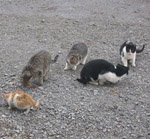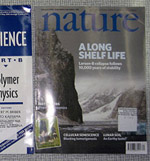Climate change, overfishing: together catastrophic for shallow reefs
 Kelp in Hazards Bay, Freycinet National Park, Tasmania. Image credit, Bjørn Christian Tørrissen.New research from scientists in Tasmania shows how climate change and overfishing can work together to cause extreme degradation of shallow reef communities.
Kelp in Hazards Bay, Freycinet National Park, Tasmania. Image credit, Bjørn Christian Tørrissen.New research from scientists in Tasmania shows how climate change and overfishing can work together to cause extreme degradation of shallow reef communities.
The warming of coastal waters off Eastern Tasmania (at four times the global ocean average rate!) is expanding the range of the long-spined sea urchin (Centrostephanus rodgersii) into the region. The sea urchin can completely transform the marine ecosystem by overgrazing productive kelp beds, leaving behind barrens on the rocky reefs with negative consequences for biodiversity.
Scott Ling and fellow researchers from Tasmania showed that normally predatory species such as the spiny lobster (Jasus edwardsii) would be keeping the sea urchins in check as they expand into new range. However, intensive fishing on Eastern Tasmanian reefs has reduced the stock of the lucrative lobster to approximately 2-8% of its historic biomass.
The study provides evidence that climate change and overfishing act synergistically to transform the marine ecosystem - in other words, together they cause much more damage than the sum of what each would cause individually.
The researchers set up an experiment in which they released tagged long-spined sea urchins into no-take marine protected areas and nearby fished reefs. They found that the number of tagged sea urchins re-sighted alive was much lower in the protected area (22.75%) versus than the fished reefs (66.25%). This indicates that predators can play an important role in reducing sea urchin numbers and that fishing severely limits this effect.
The researchers found further evidence of this by recording video footage of lobsters eating sea urchins in the protected area. Using the video images, they constructed a physical model of predation, which shows that only the largest lobsters - i.e those most valuable from a fishing perspective - are capable of killing the sea urchins. The authors write in wonderfully, graphic language,
"Calibrated video footage of lobster attacks revealed that only very large lobsters were successful predators of Centrostephanus rodgersii. We also observed that lobsters attacked in a consistent fashion whereby the lobster straddles the sea urchin and uses its massive first pair of walking legs to pry it from the substratum, overturn the sea urchin, and consume it through its vulnerable oral surface."
On the bright side, the study results show that marine protected areas, which restrict fishing, can serve as a tool for increasing the resiliency of shallow reefs against the negative impacts from climate change. However, if we want to deal with the problem of invading sea urchins, we need to act with urgency.
As the study authors note, once reefs are overgrazed by sea urchins to barrens, it becomes very difficult for the ecosystem to return to intact kelp beds.
--Reviewed by Rob Goldstein
Ling, S., Johnson, C., Frusher, S., & Ridgway, K. (2009). Overfishing reduces resilience of kelp beds to climate-driven catastrophic phase shift Proceedings of the National Academy of Sciences DOI: 10.1073/pnas.0907529106




 Climate
Climate
Reader Comments